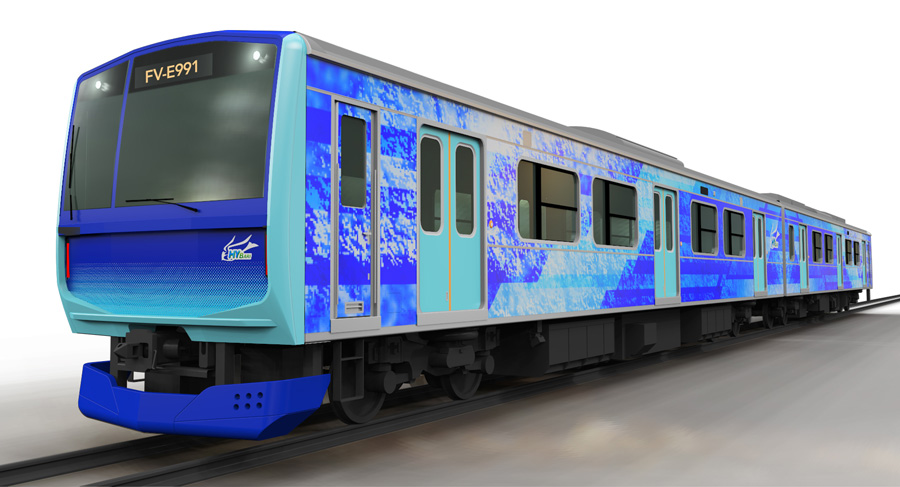Rail operators are speeding up moves to put hydrogen fuel cell trains into service. The trains are expected to help reduce CO2 emissions and boost transport decarbonisation. Japan bet on hydrogen.

The Japanese government plans to revise related regulations and push for the spread of these trains.
At the Japan Mobility Show 2023 in Tokyo earlier this month, an employee of East Japan Railway Co. (JR East) promoted the company’s “HYBARI” test vehicle, saying: “This train runs on clean energy, using hydrogen as fuel,” according to asianews.network.
The train is partly powered by a hydrogen fuel cell that uses electricity generated by a chemical reaction involving oxygen and hydrogen stored above the train body. Unlike diesel vehicles, which use diesel, hydrogen-powered vehicles do not emit CO2.
Japan bet on hydrogen
JR East completed HYBARI in 2022, with the goal of reducing its CO2 emissions to net zero by fiscal year 2050. The company estimates that replacing all 450 diesel-powered vehicles will reduce CO2 emissions by about 60,000 tonnes per year.
Demonstration tests are currently underway on its Tsurumi and Nambu lines in Kanagawa prefecture, with the aim of commercial introduction in 2030.
To generate power, HYBARI uses a durable hydrogen tank that can withstand vibration and impact during travel and has a built-in function that allows hydrogen to be released quickly in an emergency.
Improving travel distance is also a challenge. Currently, the vehicle can travel about 140 kilometres before refuelling. However, the company hopes to have increased this figure to around 300 to 500 kilometres per refuelling – equivalent to that of a diesel-powered vehicle – by the time the train is introduced.
A stable hydrogen fuelling system is essential for the widespread introduction of hydrogen trains. West Japan Railway Co. (JR West), which is considering the introduction of hydrogen-fuelled trains in the early 2030s, has announced plans to build a large-scale hydrogen station – using existing stations and lines – while at the same time running such trains.
Meanwhile, JR West plans to install a hydrogen station at Japan Freight Railway Co.’s freight station in Himeji, Hyogo Prefecture, to serve as a base for hydrogen supply and transportation.
JR West is considering future collaborations with local governments and private companies to supply hydrogen to business operators outside JR Group companies for buses, trucks and cars.
The company also plans to use its freight trains to transport hydrogen to various locations, thus contributing to a decarbonised society.
The central government has set a target of reducing CO2 emissions from the railway industry to less than half of its fiscal 2013 level by the 2030s. However, current laws and regulations do not consider hydrogen as an energy source for railways. Rather, hydrogen tanks and the like are regulated by a law relating to high-pressure gas safety, while train bodies fall under the authority of another law relating to railway operations.
Some rail operators are calling for unification of the relevant laws and regulations, saying that the current rules could prevent the widespread use and marketing of hydrogen trains.
“We would like to promote the practical application of hydrogen trains, while examining how they should be regulated in the future,” a government official said.
Currently, Switzerland, the UK, China and other countries are leading the way in the development of hydrogen trains, led by a French rolling stock manufacturer that began large-scale operation of the trains in northern Germany last summer.
A senior official in the Ministry of Land, Infrastructure, Transport and Tourism said: “To catch up with competitors abroad, the public and private sectors need to work together to effectively promote technological development and safety checks.”
Share on:



